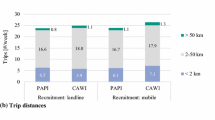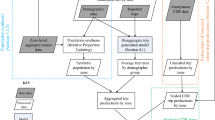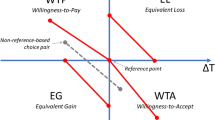Abstract
Continuous household travel surveys have been identified as a potential replacement for traditional one-off cross-sectional surveys. Many regions around the world have either replaced their traditional cross-sectional survey with its continuous counterpart, or are weighing the option of doing so. The main claimed advantage of continuous surveys is the availability of data over a continuous spectrum of time, thus allowing for the investigation of the temporal variation in trip behavior. The objective of this paper is to put this claim to the test: Can continuous household travel surveys capture the temporal variation in trip behavior? This claim can be put to the test by estimating mixed effects models on the individual, household, spatial and modal level using date stemming from the Montreal Continuous Survey (2009–2012). A mixed effects model (also know as a hierarchical or multilevel model) respects the hierarchical design of a household survey by nesting or crossing entities where necessary. The use of a mixed effects econometric framework allows for partitioning the variance of the dependent variable to a set of grouping factors, strengthening the understanding of the underlying causes of variation in travel behavior. The findings of the paper conclude that the temporal variability in trip behavior is only observed when modelling on the regional level. Further, the study suggests that a large proportion of the variance of trip behavior is attributed to different grouping factors, such as region or municipal sector for regional trip behavior models.


Similar content being viewed by others
Notes
A mixed effect model is also known in literature as a multilevel model, hierarchical linear model, and random intercept/coefficient model (Rabe-Hesketh and Skrondal 2012).
The fixed effects factor was removed from subsequent notation as the focus is more on the correct representation of the random effects.
The model was re-estimated while eliminating the hhsize variable. All parameter estimates were more or less identical. A likelihood ratio test was conducted to determine whether the model is better off without hhsize. Nevertheless, the null hypothesis could not be rejected and it was decided to keep the variable.
References
Ampt, E., Ortuzar, J.: On best practice in continuous large-scale mobility surveys. Transp. Rev. 24(3), 337–363 (2011)
Ampt, E., Stopher, P.: Mixed methods data collection in travel surveys: challenges and opportunities. In: Presented at the 28th Australian Transport Research Forum (2006)
Data Management Group.: Transportation tomorrow survey (2013) http://www.dmg.utoronto.ca/transportationtomorrowsurvey/. Accessed 2015
DiPrete, T., Grusky, D.: The multilevel analysis of trends with repeated cross-sectional data. Am Sociol Assoc 20, 337–368 (1990)
Fiona, S.: Module 5: introduction to multilevel modelling concepts. In: Learning Environment for Multilevel Methodology and Applications. University of Bristol, Centre for Multilevel Modelling (2008)
Garson, G.: Hierarchical Linear Modelling—Guide and Applications, 1st edn. SAGE Publications Inc., Thousands Oak (2013)
Goldstein, H., Browne, W., Rasbash, J.: Partitioning variation in multilevel models. Underst. Stat.: Stat. Issues Psychol., Educ. Soc. Sci. 1(4), 223–231 (2002)
Goulias, K.: Multilevel analysis of daily time use and time allocation to activity types accounting for complex covariance structures using correlated random effects. Transportation 29, 31–48 (2002)
Habib, K., El-Assi, W.: How large is too large? the issue of sample size requirements of regional household travel surveys, the case of the transportation tomorrow survey in the greater Toronto and Hamilton area. In: Presented at the 95th Annual Meeting of the Transportation Research Board (2015)
Hanson, S., Johnston, I.: Gender differences in work trip length: explanations and implications. Urban Geogr. 6(3), 193–219 (2013)
Kish, L.: Survey Sampling. John Wiley & Sons Inc, New York (1965)
Leckie, G.: Module 12: cross-classified multilevel models. In: Learning Environment for Multilevel Methodology and Applications. University of Bristol, Centre for Multilevel Modelling (2013)
Lipps, O., Kunert, U.: Measuring and explaining the increase in travel distance: a multilevel analysis using repeated cross-sectional travel surveys. In: DIW-Diskussionspapiere, vol 492 (2005)
Mahmoud, M., El-Assi, W., Habib, K., Shalaby, A.: How active modes compete with motorized modes in high density areas: a case study of downtown Toronto. In: Canadian Transportation Research Forum (2015)
Meyer, M., Miller, E.: Urban Transportation Planning, 2nd edn. McGraw Hill, New York (2001)
Ortúzar, J.D.D., Armoogum, J., Madre J.-L., Potier, F.: Continuous mobility surveys: the state of practice. Transp. Rev. 31(3), 293–312 (2011)
Peachman, J., Battellino, H.: The joys and tribulations of a continuous survey. In: International Conference on Transportation Survey Quality and Innovation (2007)
Rabe-Hesketh, S., Skrondal, A.: Multilevel and Longitudinal Modelling Using Stata. Stata Press, Texas (2012)
Roorda, M., Carrasco, J., Miller, E.: An integrated model of vehicle transactions, activity scheduling and mode choice. Transp. Res. Part B: Methodol. 43(2), 217–229 (2009)
Scott, M.A., Shrout, P.E., Weinberg, S.L.: Multilevel modelling notation-establishing commonalities. In: Scott, M.A., Simonoff, J.S., Marx, B.D. (eds.) The SAGE Handbook of Multilevel Modelling. SAGE Publications Inc. (2013)
Stopher, P., Greaves, S.: Household travel surveys: where are we going? Transp. Res. Part A 41, 367–381 (2007)
Stopher, P., FitzGerald, C., Xu, M.: Assessing the accuracy of the sydney household travel survey with GPS. Transportation 34, 723–741 (2007)
Tremblay, P.: An overview of OD-surveys in quebec (2014). http://uttri.utoronto.ca/files/2014/10/5-Tremblay-An-Overview-of-OD-Surveys-in-Quebec.pdf. Accessed 2015
Verreault, H., Morency, C.: Transcending the typical weekday with large-scale single-day survey samples. Transp. Res. Rec. J. Transp. Res. Board 2230, 38–47 (2011)
Acknowledgements
The study was partially funded by an NSERC Discovery grant. The authors would like to thank the AMT (Metropolitan Transportation Agency) for providing access to the data (continuous survey) for research purposes, as well as to Hubert Verreault (Polytechnique Montreal) for his contributions in data processing. An earlier version of the paper was presented at the 2017 International Conference on Travel Survey Methods in Montreal, Canada, and the paper has benefited from the comments and suggestions of the conference attendees.
Author information
Authors and Affiliations
Corresponding author
Ethics declarations
Conflict of interest
The authors declare that no conflict of interest.
Additional information
Publisher's Note
Springer Nature remains neutral with regard to jurisdictional claims in published maps and institutional affiliations.
Rights and permissions
About this article
Cite this article
El-Assi, W., Morency, C., Miller, E.J. et al. Investigating the capacity of continuous household travel surveys in capturing the temporal rhythms of travel demand. Transportation 47, 1787–1808 (2020). https://doi.org/10.1007/s11116-019-09981-x
Published:
Issue Date:
DOI: https://doi.org/10.1007/s11116-019-09981-x




